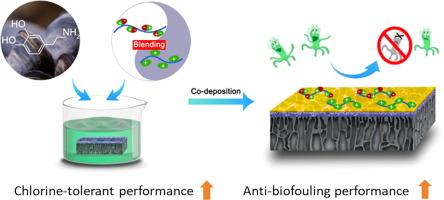当前位置:
X-MOL 学术
›
Sep. Purif. Technol.
›
论文详情
Our official English website, www.x-mol.net, welcomes your
feedback! (Note: you will need to create a separate account there.)
Chlorine-resistant and dual anti-biofouling reverse osmosis membranes with zwitterionic and quaternary ammonium copolymers via mussel-inspired one-step codeposition
Separation and Purification Technology ( IF 8.1 ) Pub Date : 2024-11-19 , DOI: 10.1016/j.seppur.2024.130615 Xinyu Zhang, Chunhui Zhang, Zhenglun Lin, Xinsheng Luo, Jingtao Xu, XiaoXiang Cheng, Daoji Wu, Congwei Luo, Feiyong Chen
Separation and Purification Technology ( IF 8.1 ) Pub Date : 2024-11-19 , DOI: 10.1016/j.seppur.2024.130615 Xinyu Zhang, Chunhui Zhang, Zhenglun Lin, Xinsheng Luo, Jingtao Xu, XiaoXiang Cheng, Daoji Wu, Congwei Luo, Feiyong Chen

|
Reverse osmosis (RO) membrane technology encounters challenges such as membrane biofouling and oxidation during practical use, which significantly hinders its further development and application. To improve the chlorine and biofouling resistance of RO membrane, we suggest a method that modifies the mass ratios of zwitterionic and quaternary ammonium copolymers in the mussel-inspired coating layer. This method successfully controls the hydrophilicity and positive charge of the membrane surface, enhancing its overall performance. The plate counting results indicate that the bacterial killing efficiency of the blended modified TFC membrane (50:50) against E. coli and S. aureus is ≥98 %. Thanks to the combined effects of the anti-adhesion zwitterionic copolymer and the antibacterial quaternary ammonium copolymer, the blended modified TFC membrane (50:50) demonstrates superior anti-biofouling performance in dynamic biofouling tests. Furthermore, the desalination performance of the blending modified TFC membrane (50:50) remains stable after long-term exposure to 60,000 ppm·h of active chlorine, while the desalination performance of the pristine TFC membrane significantly declines. In conclusion, our advancements in chlorine-tolerant and anti-biofouling RO membranes could enhance the reliability of RO technology.
中文翻译:

采用两性离子和季铵共聚物的耐氯和双重防生物污染反渗透膜,通过受贻贝启发的一步法编码沉积
反渗透 (RO) 膜技术在实际使用过程中遇到了膜生物污染和氧化等挑战,这极大地阻碍了其进一步的发展和应用。为了提高 RO 膜的耐氯性和抗生物污染性,我们提出了一种方法,可以改变贻贝涂层中两性离子和季铵共聚物的质量比。这种方法成功地控制了膜表面的亲水性和正电荷,从而提高了其整体性能。平板计数结果表明,混合改性 TFC 膜 (50:50) 对大肠杆菌和金黄色葡萄球菌的细菌杀灭效率为 ≥98 %。由于抗粘附两性离子共聚物和抗菌季铵共聚物的综合作用,共混改性 TFC 膜 (50:50) 在动态生物污染测试中表现出卓越的抗生物污染性能。此外,共混改性 TFC 膜的脱盐性能 (50:50) 在长期暴露于 60,000 ppm·h 的活性氯后保持稳定,而原始 TFC 膜的脱盐性能显着下降。总之,我们在耐氯和抗生物污染 RO 膜方面的进步可以提高 RO 技术的可靠性。
更新日期:2024-11-20
中文翻译:

采用两性离子和季铵共聚物的耐氯和双重防生物污染反渗透膜,通过受贻贝启发的一步法编码沉积
反渗透 (RO) 膜技术在实际使用过程中遇到了膜生物污染和氧化等挑战,这极大地阻碍了其进一步的发展和应用。为了提高 RO 膜的耐氯性和抗生物污染性,我们提出了一种方法,可以改变贻贝涂层中两性离子和季铵共聚物的质量比。这种方法成功地控制了膜表面的亲水性和正电荷,从而提高了其整体性能。平板计数结果表明,混合改性 TFC 膜 (50:50) 对大肠杆菌和金黄色葡萄球菌的细菌杀灭效率为 ≥98 %。由于抗粘附两性离子共聚物和抗菌季铵共聚物的综合作用,共混改性 TFC 膜 (50:50) 在动态生物污染测试中表现出卓越的抗生物污染性能。此外,共混改性 TFC 膜的脱盐性能 (50:50) 在长期暴露于 60,000 ppm·h 的活性氯后保持稳定,而原始 TFC 膜的脱盐性能显着下降。总之,我们在耐氯和抗生物污染 RO 膜方面的进步可以提高 RO 技术的可靠性。


















































 京公网安备 11010802027423号
京公网安备 11010802027423号